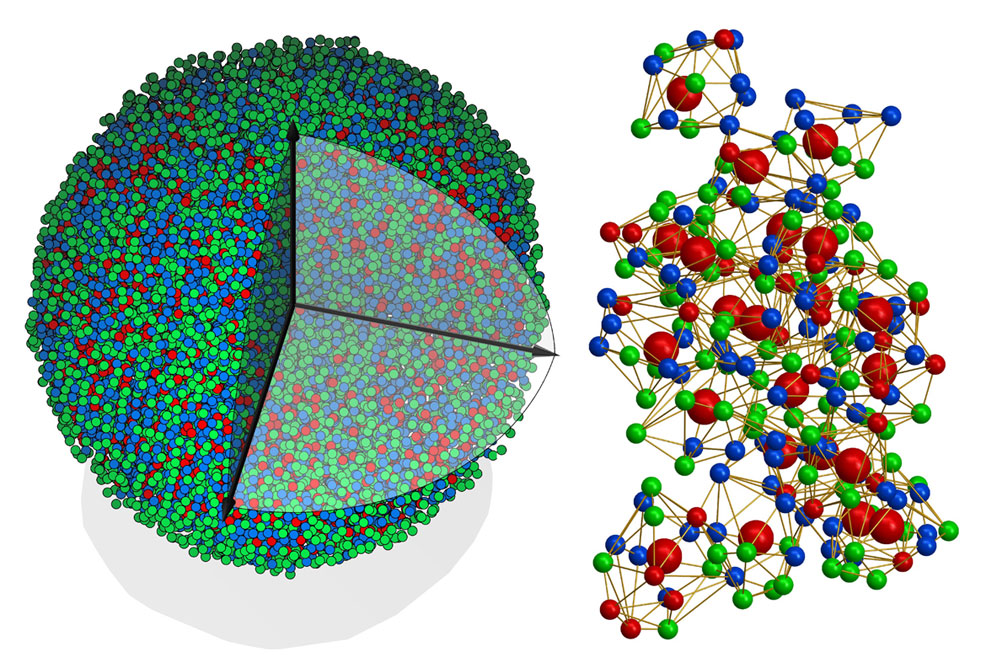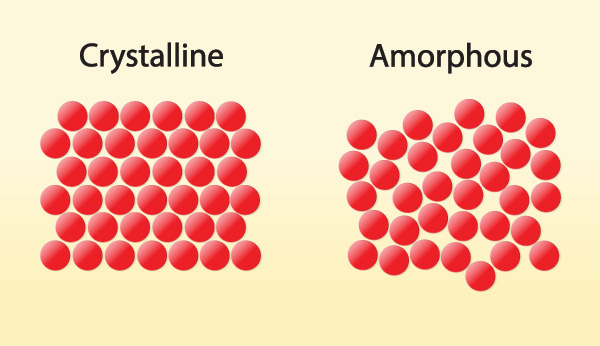
9th April 2021 First ever 3D atomic imaging of amorphous solid Researchers at the University of California, Los Angeles (UCLA), have solved a 100-year-old problem in science – capturing the 3D structure of an amorphous solid, in this case metallic glass.
An amorphous solid is any non-crystalline solid in which the atoms and molecules are not organised in a consistent lattice pattern. Such materials include glass, plastic, rubber and gel. Since the 1910s, scientists have been able to map the atomic structures of crystals – the other major class of solids – in 3D. This has led to myriad advances in biology, chemistry, physics, materials science, geology, nanoscience, and more. However, because amorphous solids are not assembled in rigid, repetitive atomic structures like crystals are, they have defied researchers' ability to determine their structure with the same level of precision. Until now, that is. A new study in the journal Nature reports on the first-ever determination of the 3D atomic structure of an amorphous solid, in this case a material called metallic glass. "We know so much about crystals, yet most of the matter on Earth is non-crystalline and we know so little about their atomic structure," said Jianwei Miao, Professor of Physics and Astronomy at UCLA, and a member of the California NanoSystems Institute. "This study just opened a new door."
The researchers used a technique called atomic electron tomography, a type of 3D imaging pioneered by Miao and colleagues. This involves beaming electrons through a sample and collecting an image on the other side. The sample is rotated so that measurements can be taken from multiple angles, yielding data that is stitched together to produce a 3D image. "We combined state-of-the-art electron microscopy with powerful algorithms and analysis techniques to study structures down to the level of single atoms," explained co-author Peter Ercius, from Lawrence Berkeley National Laboratory's Molecular Foundry, where the experiment took place. "Direct knowledge of amorphous structures at this level is a game changer for the physical sciences." The researchers examined a sample of metallic glass, measuring just 8 nanometres (nm) in diameter and made of eight different metals. Using 55 atomic electron tomography images, Miao and colleagues created a 3D map of the 18,000 atoms comprising the nanoparticle. Because amorphous solids have been so difficult to characterise, the team expected atoms to be arranged chaotically. And although 85% of the atoms were in a disordered arrangement, the researchers were able to identify pockets where a fraction of atoms coalesced into ordered superclusters. This finding demonstrated that even within an amorphous solid, the arrangement of atoms is not completely random. Metallic glasses tend to be both stronger and more shapeable than standard crystalline metals, and are used in products ranging from electrical transformers to high-end golf clubs and the housings for Apple laptops and other electronic devices. Understanding their atomic structure could help engineers design even better versions of these materials, for an even wider array of applications. "This work is a great illustration of how to address longstanding grand challenges by bringing together scientists with many different backgrounds in physics, mathematics, materials and imaging science, with strong partnerships between universities and national laboratories," said Margaret Murnane, director of the STROBE centre at the University of Colorado, which collaborated with UCLA. "This is a spectacular team."
Comments »
If you enjoyed this article, please consider sharing it:
|








